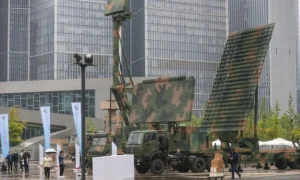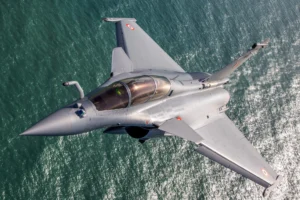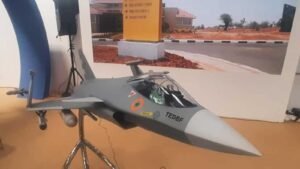
COLOGNE and STUTTGART, Germany — Tanks had fallen somewhat out of fashion — that is, before Feb. 24, 2022, when Russian tanks lined up to invade Ukraine. Conventional military lore holds that when faced with tanks on the battlefield, you’d better have your own.
And while it took more than a year, soon European and American tanks headed to the Ukrainian battlefield. This support for Kyiv has injected an almost mythical expectation into the tank as a guarantor of victory.
Indeed, Ukrainian leaders long had modern tanks near the top of their wish list of military equipment, though some Western officials tried to temper expectations that the steel behemoths’ arrival alone would yield miracles on the battlefield.
As the war draws new attention to the power and promise of the ground platforms, German and French officials are moving to reignite a joint next-generation tank program, perhaps one of the most high-profile illustrations of a renewed push for defense cooperation in Europe. After years of inaction, leaders from both countries are now vowing to make their vision for the Main Ground Combat System, or MGCS, a reality.
The stakes are high, essentially setting up yet another case study to see if European leaders can shake their national vanities and come up with a next-level weapon system. As German Defence Minister Boris Pistorius put it, the question is the “load bearing capacity” of a French-German armament program in the first place.
MGCS — a system of systems, in military speak — entails a novel main battle tank, accompanied by robots and enhanced by artificial intelligence. It is meant to replace the Leopard 2 and Leclerc fleets in Germany and France, respectively, beginning sometime between 2035 and 2040.
The idea hails from 2017, the heyday of the Berlin-Paris connection. The duo of then-German Chancellor Angela Merkel and French President Emmanuel Macron unveiled two major military projects — a new tank and a new warplane — intended to underpin Europe’s newfound defense ambitions with hundreds of billions of euros over their life cycles.
Neither project went according to plan, as the initial top-level enthusiasm gave way to industrial and political infighting over the question of which country, and which company, would lead them.
While the warplane program limped along, the tank initiative simply went quiet.
Speaking to reporters in Berlin this summer, Pistorius and his French counterpart Sébastien Lecornu said they were ready to turn the page after a drawn-out workshare distribution kerfuffle paralyzed the program. French officials had been wary that the inclusion of Germany’s Rheinmetall into the contractor pool, led by KNDS (a German-Franco joint venture of Krauss-Maffei Wegmann and Nexter), would make the project lean too Teutonic.
Krauss-Maffei Wegmann and Rheinmetall are Germany’s Leopard vendors; Nexter is the prime contractor for the French Leclerc.
But besides proclaiming a new can-do attitude and the pledge to meet again this month, there was little to announce in Berlin other than the fact there is now a mutual understanding that Germany will lead the tank program while France spearheads the warplane push, known as the Future Combat Air System, or FCAS.
Defense officials from both countries now hope experience with the FCAS program’s structure and workshare arrangements, however shaky, can propel the tank program forward. That includes the so-called pillar design — groupings of discrete capabilities like propulsion or sensors, each led by one company and supported by a smattering of subcontractors — that could be harvested even if the overall program fails.
In the case of the new tank, the two nations’ army chiefs are expected to come up with a kind of vision paper for the vehicle before the next Pistorius-Lecornu meeting scheduled for Sept. 22. By the end of the year, officials plan to digest the ideas into a single document that Macron and now-German Chancellor Olaf Scholz can use to chart a course.
From there, industry executives have said the onus is on the two governments to convey everything from cost expectations to envisioned performance features.
Ralf Ketzel, who leads Krauss-Maffei Wegmann, told the Münchner Merkur newspaper in August that “nobody has spoken with us about the financial requirements.” Rheinmetall is similarly taking a wait-and-see approach.
So far, government officials are sure only about a certain unpredictability of the end result: The tank that will one day roll out of a factory “will look nothing like today’s tanks,” Lecornu said in Berlin.
Built from scratch
The emphasis by both ministers on a new development comes after Krauss-Maffei Wegmann and Rheinmetall signaled privately and publicly they would be able to go it alone with their tank expertise if the Main Ground Combat System program fails.
“We are certain that the Leopard 2, as the world’s most advanced main battle tank, will remain the European main battle tank for decades to come,” a KNDS spokesperson told Defense News.
As for MGCS, the Franco-German company’s “conceptual understanding” is that the envisioned architecture will entail “large-caliber duel capability” as well as unmanned turrets, manned-unmanned-teaming, the ability to deploy and defeat drones, laser technology and beyond-line-of-sight strike weaponry, the spokesperson said.
The main focus of the requirements is likely the vehicle’s firepower, including the type of gun and shell ammunition the tank will employ, said Gaspard Schnitzler, research director at the French Institute for International and Strategic Affairs.
KNDS has proposed a 140mm cannon, while Rheinmetall prefers a 130mm cannon. It remains to be seen which design will make the cut, but the winner will likely determine the NATO standard for a future tank cannon, Schnitzler noted.
Another decision pertains to the balance between mobility, weight and the ability to withstand hits. During Russia’s invasion of Ukraine, both sides have used missiles, unmanned systems, artillery and loitering munitions to crack open armored vehicles. Planners are expected to study those engagements, determining the placement and types of armor reinforcement — to protect elements like the more vulnerable roof and engine sections — while keeping the future tank light enough to use civilian transportation infrastructure for a ride into combat.
To be sure, the German Defence Ministry doesn’t see a direct link between the war in Ukraine and the renewed MGCS push. Asked about lessons learned from the war that could inform features of the envisioned tank, a spokesperson told Defense News there aren’t any because “such scenarios” are already baked into whatever requirements officials previously defined.
The program delay so far makes it difficult to predict if the project will be ready for a time when both nations’ tank fleets are inoperable. That means the pressure is on for France and Germany’s industries to launch this project, but especially for the former.
Germany dominates the European land vehicle market, and its products, chiefly the Leopard tank, have been exported far and wide, compared to Nexter’s Leclerc. France needs the MGCS to reinvigorate its production lines since the Leclerc ceased production in 2008, Schnitzler said.
Meanwhile, German news reports have indicated Krauss-Maffei Wegmann expects to produce its most modern Leopard 2, the A8 variant, through 2032.
“The French really need this tank by 2035, or even 2040 at the latest, while the Germans have an intermediate solution,” which means they could wait until 2045 or so, Schnitzler said. “There’s a risk of a timetable that’s not the same.”
The objectives of the MGCS project, meant to push the envelope of what tanks can do in the 21st century, make the compressed timeline even more “ambitious,” said Dan Darling, a market analyst at the U.S.-based firm Forecast International. When factoring in a potential change in government for both nations in the next several years — Germany’s next federal elections are scheduled for 2025, while France will elect a new president in 2027 — the pressure just keeps increasing, he noted.
Neighborly interest
As German and French industry officials remain skeptical, some neighboring governments are cautiously rooting for the project, weighing their options for getting involved.
Italian junior defense minister Isabella Rauti said in July a planned purchase of Leopard 2 A8 tanks would keep Rome in play for a role in the Main Ground Combat System program, helping Italy get more closely involved with German industry.
Britain is believed to have retained an interest in the Franco-German program but is also undertaking studies of its own, keeping the door open on other possible platforms, technologies and partner options.
“The U.K. is conducting studies into a future ground combat system along with its technology enablers,” a spokesperson for the British Defence Ministry told Defense News. “This is in coordination with MoD’s science and technology and [British] Army experimental work, and aligns with similar initiatives in Europe and the U.S.”
Britain has discussed signing up at some level on the European program for at least two years, and previously responded positively to taking on an observer status with the MGCS program. British officials said they expect France and Germany to discuss the status of the MGCS program and outline the next steps in the coming months.
For the moment, though, the prime focus of British heavy armor interest is centered not on a next-generation tank but rather upgrading the Army’s aging Challenger 2 tank fleet under a contract awarded to Rheinmetall BAE Systems Land. That work, to the tune of £800 million (U.S. $1 billion) would extend the vehicles’ service lives to around 2040, with 148 tanks of the new Challenger 3 standard to reach the force beginning 2027.
Poland’s government considered partaking in MGCS, but ultimately decided to focus on the more near-term threat of Russia following the invasion of Ukraine, by signing tank contracts with the United States and South Korea.
“Poland was observing this project with interest, and was analyzing the possibility of joining it as it was awaiting the reception of indispensable data, as it has been notified to our German and French partners during talks at various levels,” a spokesperson for the Polish Defence Ministry told Defense News. “Due to the distant implementation schedule of the MGCS project and the lack of decisions on its final form, a decision has been taken to reinforce the Polish Armed Forces with M1 Abrams and K2 Black Panther tanks.”
This said, should Warsaw receive the data it is awaiting, “we will make relevant analyses” with regard to MGCS, according to the spokesperson.
The representative also said the Polish military’s Technical Modernization Plan foresees the acquisition of new tanks under the Wilk program “based on the [Polish] industry or in cooperation with a foreign partner, taking into account the necessity to develop the Polish defense potential.”
This indicates that in the coming years, Warsaw could opt to develop a new tank model in partnership with foreign industry players, including European groups.
Last year, Poland signed a deal worth about $4.75 billion to buy 250 M1A2 Abrams SEPv3 tanks. In January 2023, the country inked a second contract, valued at about $1.4 billion, to acquire 116 used M1A1 Abrams from the United States.
Poland also signed a deal last year to procure about 1,000 K2 Black Panther tanks: 180 units produced by Hyundai Rotem in South Korea, and 820 tanks in the K2PL version to be jointly manufactured by the two nations’ industries.
Across the pond
Meanwhile, the U.S. military appears in no hurry to replace its main battle tank, the venerable Abrams. First fielded in the 1980s, the U.S. Army has banked on upgrade programs ever since, a strategy that is unlikely to change anytime soon, according to analysts.
Manufacturer General Dynamics unveiled its own concept for a next-generation tank, dubbed Abrams X, at the 2022 annual convention of the Association of the United States Army in Washington, but no government program has emerged to that end.
That is because other programs are deemed more important to the U.S. military portfolio, said Mark Cancian, a senior adviser with the Center for Strategic and International Studies think tank in Washington.
For one, the Bradley infantry fighting vehicle is “more vulnerable” and needs to be replaced sooner, Cancian said. Additionally, “there is much more interest in air defense and long-range precision strike.”
There is also the question of whether investments in newfangled tanks are worth it, given the ubiquity of stand-off anti-tank missiles and mines.
“If the Army went to the Office of the Secretary of Defense or Congress and said, ‘We want to start a new tank program based on what we’re seeing in Ukraine,’ most people would say, ‘That’s not what we see,’ ” Cancian said.
Sebastian Sprenger reported from Cologne and Vivienne Machi from Stuttgart in Germany; Andrew Chuter from London; and Jaroslaw Adamowski from Warsaw, Poland.
Sebastian Sprenger is associate editor for Europe at Defense News, reporting on the state of the defense market in the region, and on U.S.-Europe cooperation and multi-national investments in defense and global security. Previously he served as managing editor for Defense News. He is based in Cologne, Germany.
Vivienne Machi is a reporter based in Stuttgart, Germany, contributing to Defense News’ European coverage. She previously reported for National Defense Magazine, Defense Daily, Via Satellite, Foreign Policy and the Dayton Daily News. She was named the Defence Media Awards’ best young defense journalist in 2020.
Andrew Chuter is the United Kingdom correspondent for Defense News.
Jaroslaw Adamowski is the Poland correspondent for Defense News.
Source by [author_name]
#Berlin #Paris #pull #tank






